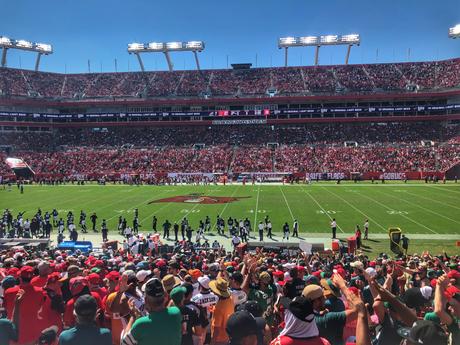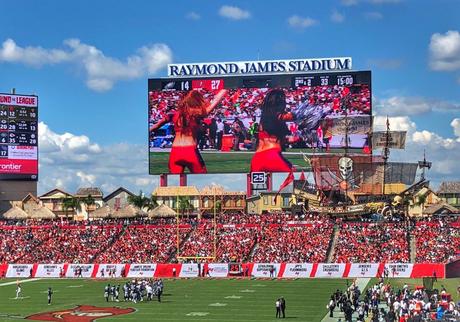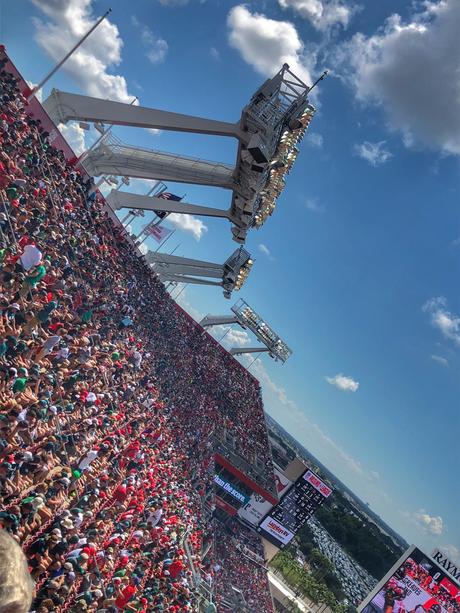Forgive me for a momentary diversion away from the beautiful game but I am sure if you bear with me you will see the relevance of this post to the wonderful world of (proper) football.
In little over a week one of the biggest events in world sport is due to take place in Tampa, Florida – The Super Bowl. The fifty-fifth final of the NFL season is between the Tampa Bay Buccaneers and the Kansas City Chiefs, and for the first time it is happening at the stadium of one of the finalists, the Raymond James Stadium located on the outskirts of Tampa.

This is the second successive Super Bowl that the state of Florida has hosted. A year ago the Chiefs won the title, beating San Francisco 49ers in the Hard Rock Stadium in Florida. Nearly 62,500 fans were lucky enough to get a ticket and be in the arena as Kansas won their first title in fifty years. As is the case every year come Super Bowl time, demand for tickets far exceeds supply, leading to a very active secondary market on the ticketing websites such as Stubhub, Let Me In and Viagogo.
Each club only gets a small allocation of tickets and with most NFL stadiums sold out to season ticket holders, the majority of a side’s loyalist fans will be unlucky, year after year. Last season in Miami the average price of a ticket bought on the secondary market about $7,000, according to StubHub’s analysis of tickets resold through their site, although the site also had hospitality tickets in the 72 Club for “just” $60,000.
This season’s NFL campaign has been played out against the worsening COVID-19 pandemic, with each team having their own rules as to how many fans could watch games in the stadium based on a number of factors including the advice of local authorities. For instance, at the home of the 2020 Super Bowl in Miami, the Dolphins decided not to open their stadium to fans at full capacity despite Florida Governor Ron DeSantis giving clearance for them to do so, restricting capacity to 13,000 fans for its home games. In New Jersey’s MetLife Stadium, home to the New York Jets and Giants, no fans have been allowed in to watch them. The newest stadium and team in the league, the Las Vegas Raiders 65,000 capacity Allegiant Stadium just off the strip was empty for the franchise’s first season in the NFL.
Down in Tampa, the Buccaneers, owned by the Glazer family, had been playing in front of 25% capacity, the maximum allowed under NFL and CDC (Center for Disease Control) guidelines, or in other words around 17,500 fans.

However next Sunday the stadium will host approximately 22,000 fans, with 7,500 healthcare workers invite to attend as guests of the league. It isn’t all about the good nature of the sport though. The increasing number of cases and deaths has shocked the US public and many will be questioning the continuation of the game, let alone having such a big crowd in one place when there are still so many restrictions elsewhere in everyday life.
Every one of the invited healthcare workers will have had their first vaccination shot, a fact that will be heavily promoted to try to encourage the millions watching to do likewise. The guests will come from the staffs of hospitals and health care systems in the Tampa area and other cities that the 32 NFL franchises call home in a move that the authorities will also hope will convey the message that the health workers are the key to winning this battle.
For those teams that were able to play in front of fans there were significant restrictions in place. All spectators had to wear masks and sit in social distancing pods, whilst concourse areas were heavily regulated. US sports are built on the principle of socialising. The plethora of food and drink outlets, the frequent breaks and the fan engagement and interaction across all major sports have been part of the DNA of fans for decades. Seeing quarter-full stadiums, restricted movement and social distancing simply isn’t what many US fans want to see or be part of. Others may see the fans in the stadium next Sunday and feel that the immediate danger of the virus has passed and it is now fine to go back to behaviours before the COVID outbreak.
Lee Igel wrote in Forbes last week about the issues of bringing so many fans together could have.
“Whenever large numbers of people are congregating, screaming, and yelling anywhere, for any amount of time, even outdoors, there has to be concern for it becoming a superspreader event. A highly-organized effort around a sports mega-event like the NFL is orchestrating for the Super Bowl can lessen that likelihood. No doubt, NFL and local officials are doubling and, most likely, tripling procedures to keep people safe. But the issue here is as much about people’s behavior when they are in the stadium as it is when they are away from it. Where and how are they moving around before and after? Are they wearing masks and keeping appropriate distances when they go out in public?”
Last year in the UK there was considerable criticism aimed at the authorities for allowing the Cheltenham Festival, Horse Racing’s biggest annual event, to take place with over 250,000 fans cramming into the famous racecourse over a five day period in March just as the virus began to run out of control. The term “superspreader event” was used for the meeting although it is incredibly difficult to trace source infections back when so many people from so many global locations come together.

The Super Bowl will be a similar concern. Tampa is a big city and there must be a sense of relief that the host team are in the Super Bowl as that will reduce the number of fans traveling from outside the city area. But there will still be thousands arriving at Tampa airport in the run up to the game and traveling into the city center for a few days. Then there will be the issue of getting fans safely to and from the stadium – like most NFL grounds the Raymond James Stadium is located some way from the city center and as the car is king in the US, public transport is limited. The city may lay on shuttle bus services but that obviously comes with a heightened risk of social contact.
As Igel said, in finishing off his piece in Forbes, “The NFL cannot police fans’ behavior outside of its venues. Nor should it be held accountable for doing so. But the league does have a social and moral responsibility to communicate the right messages to the public. Using its platform to recognize health care workers during the Super Bowl does that. Opening the doors to a large crowd and suggesting that all is well does not.”
Hindsight is a wonderful thing and the authorities will be praying that in three months time people will be talking about what happened on the field at The Raymond James Stadium and not in the stands, bars, restaurants and hotels in Tampa. The world will be watching with interest, with clubs, authorities, fans and players across the globe hoping that this is the first step to a return to competitive action as soon as it is safe to do so, not least so the Premier League who want to bring fans back into the stadiums in England as soon as possible to increase the opportunities to market the league overseas, whilst a decision on the viability of hosting the already delayed European Championships will need to be made very soon, especially with Wembley and Hampden Park due to host matches.

